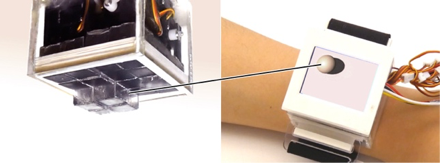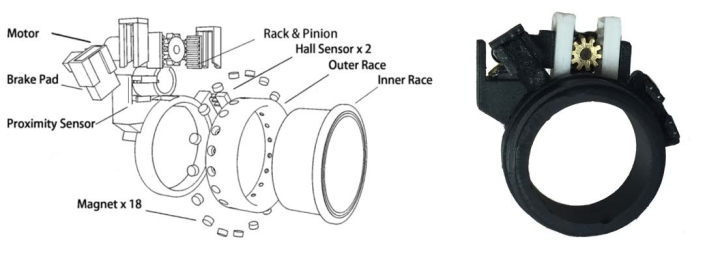Innovative smart watch and smart ring designs to feature alongside other top tec
HANOVER, N.H. – October 20, 2017 – A watch that works in multiple dimensions and a smart ring that provides calendar alerts are among the top technology Dartmouth College will bring to the 30th ACM User Interface Software and Technology Symposium (UIST 2017).
Image  The 2.5D RetroShape smart watch (above) and Frictio, a ring that alarms its wearer (below), are among Dartmouth’s offerings at UIST 2017. Top photo © Da-Yuan Huang. Bottom photo © Teng Han
Image  |
Other technology to be introduced by the Dartmouth team includes a thumb-tip recognition technique that optimizes interaction with computer applications.
The research projects, products of Dartmouth’s human computer interface lab, have been chosen by UIST 2017 to feature alongside some of the world’s most innovative technology.
“Understanding and improving how humans interact with computers are essential parts of technology development,” said Xing-Dong Yang, assistant professor of computer science at Dartmouth. “We look forward to UIST as a unique opportunity to share ideas on innovation.”
RetroShape: A Smart Watch that Takes Users into Another Dimension
Imagine viewing a video or playing a game on a smart watch and having the device provide feedback that allows you to feel a ball bounce or an asteroid explode. Dartmouth’s RetroShape does just that.
Seeking to improve the user experience with smart watches, RetroShape uses a shape-deforming watch back that allows the user to view and feel virtual objects.
Each pixel on RetroShape’s screen has a corresponding tactile pixel—or taxel—on the back of the watch face, allowing the virtual world to be extended to the 2.5D physical space on its back. The construction allows watch developers to use the wearer’s skin under the watch face for feeling output that matches the visual content being displayed on the watch.
The back to the watch face is constructed using 16 independently moving pins that allows for the real-life rendering of shapes and movement. Link here for a video demonstration of RetroShape.
Frictio: A Smart Ring That Focuses on Output
While most designs use smart rings to receive instructions from the wearer, Dartmouth’s Frictio is the first of its kind to provide useful feedback.
Frictio, composed of a ring, a braking-system and electronics, provides sensory feedback through six separate force profiles that provide information to the user. If a wearer has plenty of time before the next meeting, the ring calendar reminder could be set to rotate freely. Only five minutes left before that meeting, the ring could be made to move with heavy resistance or forced to stop completely.
“Designing a smart ring that provides information rather than just receiving inputs can unlock the true potential of these devices,” said Yang. Link here for a video demonstration of Frictio.
Pyro: Intricate Computer Tasks at the Tips of Your Fingers
Moving the thumb tip against the index finger is an optimal method for performing computing inputs. The gesture is natural, subtle, fast and unobtrusive. The input method requires little effort from users and introduces minimal fatigue over other input methods that require more extreme gestural movements.
Dartmouth’s Pyro is a technique for thumb-tip recognition that senses thermal signals radiating from fingers to recognize gestures. Using a low-cost, off-the-shelf infrared sensor, researchers have created an improved system for using finger gestures to interact with computing applications, and have demonstrated effectiveness at gesturing forms of basic shapes, a check mark and even a question mark.
Not only is the infrared sensor used in the Pyro system highly sensitive to subtle motion and enables recognition of fine gestures, it has other important benefits: the system is energy-efficient and it requires no cooling. Both characteristics are important for small consumer devices and wearables.
According to Pyro researchers: “Our work provides the first evidence to support pyroelectric infrared sensing as a promising alternative for detecting micro finger gestures.” Link here for a video demonstration of Pyro.
Dartmouth researchers also participated in other technology being featured at UIST 2017, including a modular mobile phone that is tailor-made for lending to friends, family members or even strangers.
Dartmouth researchers that led the technology development projects include Jun Gong (Pyro), Da-Yuan Huang (RetroShape) and Teng Han (Frictio).
UIST takes place from October 22 through October 25 in Quebec City, Canada.
###
The following websites may be viewed for videos on Dartmouth’s UIST 2017 technology:
RetroShape: http://dartgo.org/retroshapevideo
Frictio: dartgo.org/frictiovideo
Pyro: dartgo.org/pyrovideo
Modular mobile phone: dartgo.org/modularphonevideo
During UIST 2017, Xing-Dong Yang may be reached at: xing-dong.yang@dartmouth.edu
About Dartmouth
Founded in 1769, Dartmouth is a member of the Ivy League and offers the world’s premier liberal arts education, combining its deep commitment to outstanding undergraduate and graduate teaching with distinguished research and scholarship in the arts and sciences and its three leading professional schools: the Geisel School of Medicine, Thayer School of Engineering and Tuck School of Business.

